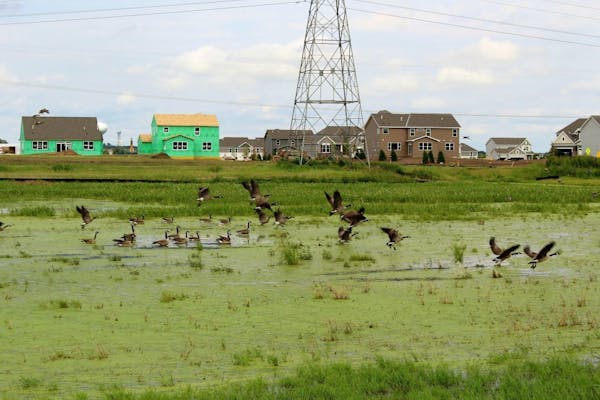Part 3 of 4 in a series, "Our changing cities."
The Twin Cities' ability to grow increasingly depends on what lies beneath the surface in rural Dakota County: sand and gravel.
The southeast metro area is home to the last readily available source of aggregate in the Twin Cities, and the region's mining operations are shifting there to unearth it, according to new land use data collected by the Metropolitan Council and analyzed by the Star Tribune.
The city of Rosemount and Empire, Eureka and Sciota townships in Dakota County have added more acres of mining — 760 — than any other place in the metro area between 2010 and 2016.
"A lot of the other sources around the metro are depleted," said Mark Setterstrom, general manager of Dakota Aggregates. "And there simply is only aggregate in certain parts of town."
Aggregate is a key ingredient in building materials like concrete and asphalt for roads and other construction. The metro area consumes about 27 million tons of the material each year — enough to fill the old Metrodome eight times.
About half of the aggregate is used for public projects like roads, bridges and schools, and it costs a lot to transport longer distances, said Heather Arends, mineral potential section manager at the Department of Natural Resources.
"Having local sources is really key in keeping the cost of projects down," Arends said.
The Met Council flies over the seven-county metro area every five to seven years to determine how every inch of land is being used, aided by property assessment records. It isn't perfect — the analysis relies on human judgment, sometimes correcting past imperfections — but cities across the region use the detailed maps and data to plan for the future. The Star Tribune compared the Met Council's 2016 survey with its last flyover in 2010, and the shift in mining operations was clear.
The aggregate mines in the southeast metro now account for 25 percent of mining acreage metrowide, up from 10 percent during the last survey. That's partly due to the opening of a major new mine at the UMore Park property in Rosemount and Empire.
The new mine changed the landscape for Leslie Green and her neighbors, some of whom were wary at first about the industry moving into the area better known for its farms. But so far, the mining company has been responsive to her concerns, building a taller berm, moving a washing facility and installing quieter machinery.
That said, she will be happy when the mine closes — someday far in the future.
"Nobody wants these things in their backyard," Green said.
When mining stops, the land often opens for development. Maple Grove opened a new central park in 2015 on what was, until recently, a gravel mine. A new Hy-Vee sits atop a former mine in Lakeville.
In some cases, development happened before there was a chance to mine the aggregate. Southdale Center, for instance, sits atop a large aggregate deposit.
Last year, the Legislature created an Aggregate Resources Task Force to study the dwindling supply of sand and gravel. The last major analysis in 2000 concluded that the metro area could run out of aggregate between 2029 and 2034 if development patterns continued. But that report did not anticipate the recession.
Met Council staff said two recently permitted mines in Empire and Rosemount are expected to meet about a third of the metro area's annual demand until about 2040 or 2050. Other cities including Maple Grove, Burnsville and Apple Valley also have more than 300 acres of land each devoted to mining.
Some communities, such as Empire Township, have created mining overlay zones specifically to ensure development doesn't pave over mining resources.
"This idea of actually designating a mining area and not allowing any other development really is critical," said Fred Corrigan, executive director of the Aggregate & Ready Mix Association of Minnesota. "And if we're doing that, we probably don't need to worry for the next 40 or 50 years."
A map from that 2000 report, below, illustrated that the southeast metro area contained the bulk of the region's remaining, readily available sand and gravel resources (in red).
Source: 2000 Aggregate Resources Inventory
We'd like to hear about what's happening in your neighborhood. Use our interactive map to look at land use changes in your area. Then share what you found in the comments below or on Facebook, Twitter or other social media platforms. Copy the URL from the map (while zoomed to your location) and paste it with your comments, as well

Rep. Omar's daughter arrested, suspended from college for pro-Palestinian protests
Hopkins parents charged in 9-year-old daughter's asthma death

Back to blue: Lake Harriet Band Shell renovation almost finished


